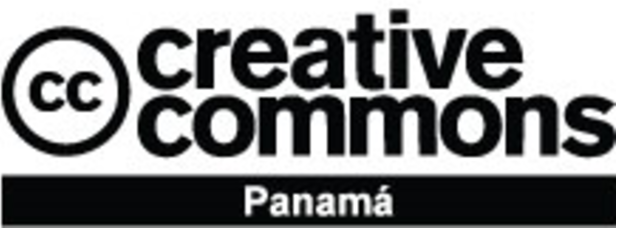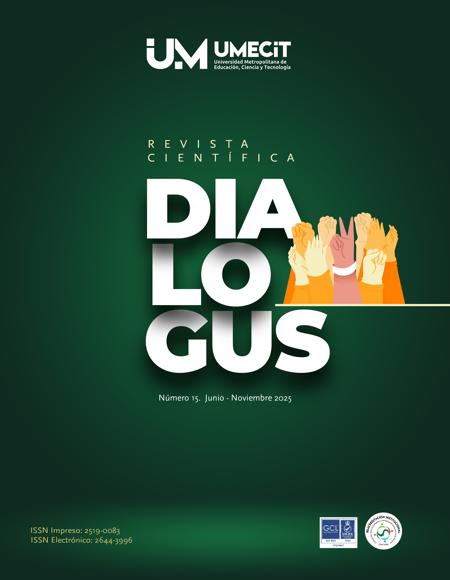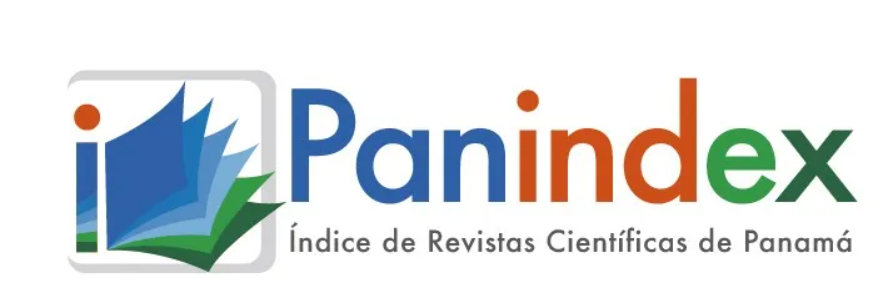The content of the publications and the links suggested in them are the sole responsibility of the authors and not of the METROPOLITAN UNIVERSITY OF EDUCATION, SCIENCE AND TECHNOLOGY (UMECIT) or DIALOGUS magazine. They are protected by international copyright laws as well as the UMECIT and DIALOGUS logos, hence their reproduction is totally prohibited.
This work is licensed under a Creative Commons Attribution-NonCommercial-NoDerivatives 4.0 International License.
The authors maintain the copyright and transfer the right of the first publication to the journal, with the article registered with Creative Commons Attribution-NonCommercial-NoDerivatives License, which allow others They can download the works published in this magazine and share them with other people, as long as their authorship is recognized, but they cannot be changed in any way nor can they be used commercially.
Authors are recommended to include their work in social networks such as Researchgate and institutional repositories once the article or visible fact has been published on the journal page, without forgetting to include the digital document identifier and the name of the journal.



Abstract
This study evaluated the influence of graphic resources on the motivation, participation, and comprehension of children with learning difficulties, specifically dyslexia, dysgraphia, and dyscalculia. Accessible visual materials were implemented in a vulnerable educational setting, designed with clear typography, simple illustrations, and soft colors. The methodology followed a mixed-methods approach, with a non-experimental, cross-sectional, and descriptive design. Data was collected through teacher surveys, classroom observation, and unstructured interviews. Results showed that the use of graphic resources had a positive effect on student interest and performance. All teachers reported improved participation, and 80% noted greater motivation and understanding. A favorable response was observed toward visual and manipulative materials, highlighting their value for cognitive and emotional development. Teachers agreed that elements such as Lexend font, soft colors, and clear imagery helped maintain attention, reduced confusion, and encouraged learning confidence. It was concluded that accessible graphic resources are effective tools to support children with learning difficulties by promoting a more inclusive and understandable learning environment. The study emphasizes the importance of designing educational materials from an accessibility and universal design for learning perspective.
Keywords
References
Acosta, Alsina, & Pincheira. (2023). Recursos manipulativos y gráficos en la comprensión de tareas con patrones: Un análisis comparativo con niños de 4 a 6 años. Universitat de Girona. https://www.seiem.es/docs/actas/25/Comunicaciones/119.pdf?utm_source=
Alonso, A., Foces, J. M., & Fernández, M. A. P. (1993). Hacia un lenguaje gráfico en la enseñanza. Comunicación, Lenguaje y Educación, 5(18), 55-66. https://doi.org/10.1080/02147033.1993.10821073
Artola, E. C., Mayoral, L. E., & Benarroch, A. (2016). Dificultades de aprendizaje de las representaciones gráficas cartesianas asociadas a biología de poblaciones en estudiantes de educación secundaria. Un estudio semiótico. Revista Eureka sobre Enseñanza y Divulgación de las Ciencias, 13(1), 36-52.
ASJ. (2021). Problemas y Propuestas-Repensar Honduras-Educacion.pdf.
Asociación Andaluza de Dislexia. (2010). Guía general sobre Dislexia.
British Dislexia Association. (2015). Guía de estilo para dislexia. British Dislexia Association.
El Heraldo. (2024). El bajo rendimiento y falta de recursos afectan aprendizaje de los niños en Honduras. www.elheraldo.hn. https://www.elheraldo.hn/fotogalerias/honduras/bajo-rendimiento-falta-de-recursos-afectan-aprendizaje-ninos-honduras-HL19210722
El Reglamento de Educación Inclusiva de Honduras. (2021).
Gilliam Scott, R. (2002). Fundamentos del diseño. Victor Leru. https://eacvvcae.wordpress.com/wp-content/uploads/2014/02/l-fundamentos-disec3b1o_scott.pdf?utm_source=
Godinho, S. de S., Rivela, C. V., Medrado, S. O., Marmo, J., & Lanuque, A. (2020). Educación inclusiva y accesibilidad digital. Revista Científica Arbitrada de la Fundación MenteClara. https://www.redalyc.org/pdf/5635/563579383010.pdf
Iris Center. (2020). Uso de organizadores gráficos. IRIS. https://iris.peabody.vanderbilt.edu/module/sec-rdng-spanish/cresource/q3/p11/
López, L. N. (2023). Dislexia, Disgrafía, Discalculia. : Definiciones, Evaluaciones y Tratamientos.
Perelló, I. (2008). La Dislexia y el diseño gráfico.
Puyuelo, M., Val, M., Erino, L., & Gual, J. (2017). Diseño inclusivo y accesibilidad a la cultura. Universitat Politècnica de València.
Robayo-Abril, M., Rude, B., Cadena, K., & Espino, I. (2023). Una senda hacia la reducción de la pobreza y el crecimiento inclusivo. World Bank Group. https://openknowledge.worldbank.org/server/api/core/bitstreams/7fa5f090-ee2c-4ddc-bdc0-9394f9aa18ba/content
Suárez-Carballo, F., Galindo-Rubio, F., & Martín-SanRomán, J.-R. (2018). La simplicidad en el diseño de marcas gráficas: Análisis de la preferencia. Arte, Individuo y Sociedad, 30. https://doi.org/10.5209/ARIS.56791
UNESCO. (2020). Informe de seguimiento de la educación en el mundo, 2020: Inclusión y educación: Todos y todas sin excepción—UNESCO Biblioteca Digital. https://unesdoc.unesco.org/ark:/48223/pf0000374817?posInSet=3&queryId=fdc3c2ee-3832-4e57-b19f-8e10d4942db7
Vanderbilt Kennedy Center. (2014). Apoyo Visual. https://vkc.vumc.org/assets/files/resources/visualsupportsddsp.pdf?utm_source=
Wilter Wilfrido, M. O., & Idelisa Esther, C. B. (2022). Las imágenes como recurso visual para potenciar la comprensión lectora en los niños de 4-5 años. Universidad Técnica de Manabí.
Yandar Cumbal, D. A. (2021). La importancia de los recursos gráficos en la educación.
Downloads
Publication Facts
Reviewer profiles N/A
Author statements
- Academic society
- Universidad Metropolitana de Educación, Ciencia y Tecnología
- Publisher
- Universidad Metropolitana de Educación, Ciencia y Tecnología




















